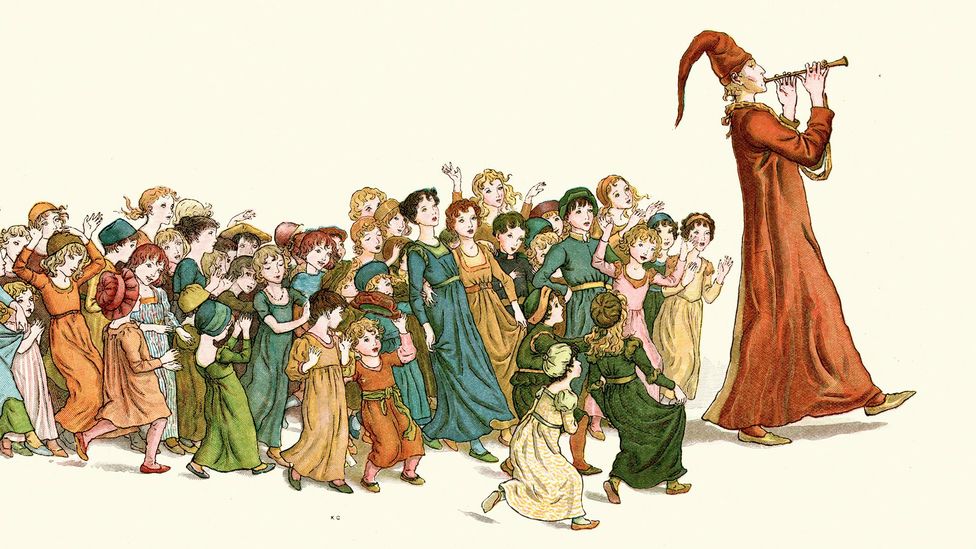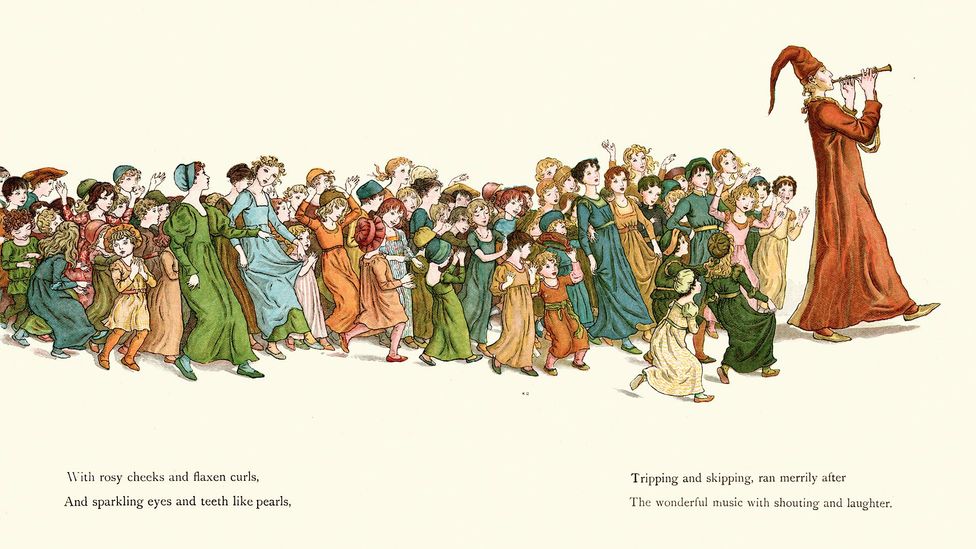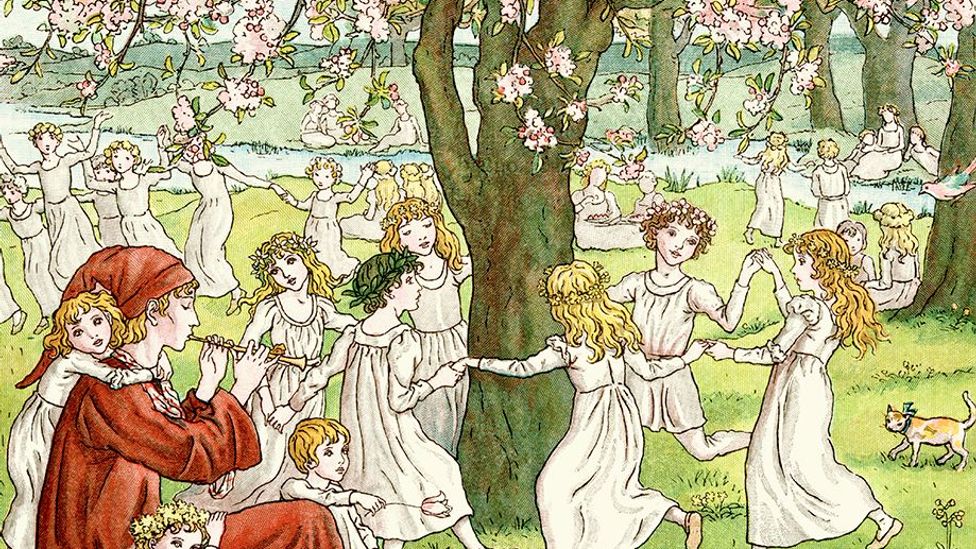Could a Baby Born in the 17th Century Survive Being 2 Months Early
The grim truth backside the Pied Piper
(Epitome credit:
Kate Greenaway/duncan1890/Getty Images
)

Writers like the Grimm Brothers and Robert Browning may take shaped the Pied Piper legend into art, but it turns out the story is likely based on an actual historical incident.
(This yr, we published many inspiring and amazing stories that made us autumn in honey with the world – and this is one our favourites. Click here for the total list).
Every working morning time for the last 26 years, Michael Boyer has slipped into a pair of neon-bright, multi-coloured tights, tied on his lipstick-red cape, grabbed his flute and marched out into the medieval streets of Hamelin, a town of 60,000 residents in Lower Saxony, Germany.
"People sometimes mistake me for a superhero, courtroom jester or Robin Hood," he laughed. He'south besides increasingly become an Instagram prop for tourists and, possibly in some woke eyes, a gender-fluid statement.
But virtually people recognise him for what he is, the Pied Piper incarnate, appointed by Hamelin to impersonate its simultaneously favourite (at least commercially) and least favourite adopted son. Responsible for coming together and greeting visiting groups and dignitaries, he leads tours of the urban center and embodies the enduring hold of the legend that draws most travellers here.

Michael Boyer dresses up every bit the Pied Piper incarnate and leads tours of Hamelin, Germany (Credit: Mano Kors/Alamy)
The tale in fact has survived for a very long time. Originating equally medieval sociology, the story inspired a Goethe verse, Der Rattenfänger; a Grimm Brothers' legend, The Children of Hamelin; and one of Robert Browning'south best-known poems, The Pied Piper of Hamelin. And although each writer tinkered with the story, the basics remained the same: the Piper was hired by Hamelin to rid the boondocks of its plague of rats. Trailing after the hypnotic notes of the rat-catcher's magical flute, the rodents politely filed through the city gates to their presumed doom.
They weren't the only ones lured past his music, though. When the boondocks refused to pay the Piper for his service, the saviour turned into a more satanic seducer and came for Hamelin'southward children. Entranced by the notes of his flute, the transfixed boys and girls followed the Piper out of town and only vanished.
While the tale has endured, then has Hamelin itself, which still looks equally though information technology belongs in a fairy tale. Boyer's bout leads visitors past rows of half-timbered houses. There are 16th Century burgher manors encrusted with Gothic gables and scrollwork, and flamboyant wedding cake buildings offering prime examples of the local Weser-Renaissance architecture, all leering gargoyles and brightly coloured polychrome wood carvings.
However, all this is just background for the boondocks'due south real cottage manufacture, which cashes in on all things Piper. The local restaurants plate a "rat tail" signature dish made from thinly sliced pork, and the bakeries practise a brisk business concern in rodent-shaped breads and cakes. The Hameln Museum offers a sound and low-cal Pied Piper re-enactment; local actors put on an open-air Pied Piper play during summertime; and the gift shops militarist their own rat-inspired memorabilia. You can get home, if y'all wish, loaded down with Pied Piper T-shirts, fridge magnets, mugs and flutes.

Hamelin, Deutschland, nevertheless looks every bit though it belongs in a fairy tale (Credit: Gonzalo Azumendi/Getty Images)
What could laissez passer for mere comic relief, though, masks something deeper, and suggests why the fable lives on not only in Hamelin merely in enduring sociology. On some level, the tale stokes a fundamental fright, with the Piper a version of a universal bogey man that continues to haunt the states. Parents everywhere still fear the loss of their babies. Children, popping up on the nightly news, still become missing every day. And so we all ultimately vanish in something like an instant. The Piper, in the stop, is ane very grim reaper.
But if the tale evokes a universal fear, it still resonates about strongly in Hamelin – and the Piper'southward tour suggests why. In fact, the real surprise of his tour isn't so much the beautifully preserved townscape but the suggestion that the Pied Piper is much more than merely a fairy tale. The Grimm Brothers and Browning may have shaped the legend into art, but the story, it turns out, is likely based on an actual historical incident.
You lot may as well be interested in:
• The elusive hidden people of Republic of iceland
• Is it fourth dimension to rewrite fairy tales?
• How a German city changed how nosotros read
The proof is etched on Hamelin'due south face itself. An inscribed plaque on the stone facade of the so-called Pied Piper business firm, a one-half-timbered private residence dating to 1602 – like to an even before ane etched on the building'due south window – bears explicit witness to the mystery. The inscription reads:
"A.D. 1284 – on the 26th of June – the 24-hour interval of St John and St Paul – 130 children – born in Hamelin – were led out of the town by a piper wearing multicoloured clothes. After passing the Calvary near the Koppenberg they disappeared forever."

Entranced past his flute, the transfixed children of Hamelin followed the Piper out of town (Credit: duncan1890/Getty Images)
The inscription isn't the but clue. An entry in Hamelin'due south town records, dating to 1384, laments that, "Information technology is 100 years since our children left." The stained-glass window in the boondocks'south St Nicolai church, destroyed in the 17th Century but described in earlier accounts, reportedly illustrated the figure of the Pied Piper leading several ghostly white children. And the 15th Century Luneburg manuscript, an early German account of the effect, along with five historical retentivity verses, some in Latin and others in Middle Low German, all refer to a like story of 130 children or young people vanishing on the 26 June 1284, post-obit a pied piper to a place chosen Calvary or Koppen.
The Pied Piper and so, more a fairy tale, becomes the emblem of a profound historical mystery. What happened to the missing children of Hamelin? Still the master seducer, the mesmerising rat-catcher is now leading a whole new trail of entranced followers – this time a conga line of historians each taking their own deep dive into the question of what exactly transpired in Hamelin on 26 June 1284.
The theories are legion, co-ordinate to Wibke Reimer, project coordinator at the Hameln Museum who has been organising a special exhibit that focuses on the global reach of the Pied Piper fable. One of the leading electric current theories suggests the boondocks's youth were part of a migration of Germans to Eastern Europe fuelled by an economical depression.
"In this scenario," Reimer said, "the Pied Piper played the part of a so-called locator or recruiter. They were responsible for organising migrations to the due east and were said to take worn colourful garments and played an instrument to attract the attention of possible settlers."

Bakeries in Hamelin, Federal republic of germany, sell rat-shaped pastries (Credit: Chris Howes/Wild Places Photography/Alamy)
While some historians believe that the youth emigrated to Transylvania, the German language linguist Jürgen Udolph'due south theory is most accepted. "He suggests the regions around Berlin as the nigh probable location, in an area that'south at present [eastern Frg]," Reimer said, "and he backs up his theory by place name evidence." In fact, Udolph plant that the family names common in Hamelin at the time show up with surprising frequency in the areas of Uckermark and Prignitz, almost Berlin, that he locates equally the centre of the migration. The theory is also reinforced by evidence that the region, newly liberated from the Danes, was ripe for High german colonisation.
More than fanciful theories abound, also. Some historians suggest the fable reflects a 13th Century children's crusade, part of the moving ridge of medieval crusades aimed at winning back the Holy State. And some argue the youth were lost to the Blackness Plague, though the dates don't match upwards.
More intriguing is a theory that points to the medieval miracle of "dancing mania", driven by a succession of pandemics and natural disasters. Known as St Vitus' Dance, the dancing plague is documented surfacing in continental Europe as early equally the 11th Century. A course of mass hysteria, the dance could spread from individuals to large groups, all driven past an unshakeable compulsion to trip the light fantastic feverishly, sometimes for weeks, often leaping and singing and sometimes hallucinating to the betoken of exhaustion and occasionally decease, like a top that can't terminate spinning.
And, in fact, ane 13th Century outbreak – a literal course of dance fever – occurred south of Hamelin, in the town of Erfurt, where a group of youths were documented as wildly gyrating as they travelled out of town, ending up 20km away in a neighbouring town. Some of the children, i chronicle suggests, expired shortly thereafter, having flat-out danced themselves to death, and those who survived were left with chronic tremors. Perhaps, some theorise, Hamelin witnessed a similar plague, dancing to the figurative melody of the Piper.
Simply all these theories neglect i specific central to the Hamelin mystery. "They don't explain the very detail date cited for the loss of the children, and the local sense of trauma," Reimer noted. "Did something happen that officials had been covering up? Something so traumatic that information technology was transmitted orally for so long in the town's collective retentivity, over decades and even centuries?"

Some theorise that the Pied Piper led the youth of Hamelin to their midsummer festivities (Credit: Kate Greenaway/duncan1890/Getty Images)
In fact, the appointment chronicled in all the local documentation pinpoint 26 June as the day the children disappeared. This twenty-four hour period is besides the date of pagan midsummer celebrations. The fact the documentation also emphasises that the youth followed the Piper to the Koppen, commonly translated as "hills", propose another link. "At that place were regions in Federal republic of germany where midsummer was celebrated by lighting fires on the hills," said Reimer. All that leads to one specially macabre reading of the Pied Piper fable. Perhaps the Piper, allegorical of a heathen shaman, playing his flute, was leading the youth of Hamelin to their midsummer festivities when the local Christian faction, hoping to cement conversion of the region, waylaid and massacred the group. A less bloody theory: maybe the children were spirited away to local monasteries.
If the tale suggests a possible historical tragedy, though, it also offers an artistic redemption as well.
"The Pied Piper story," said Reimer, preparing for the debut of her exhibit on 26 June, "is to our noesis known in at least 42 countries and 30 languages, maybe more. And information technology appears in international art, literature and music. The Pied Piper is a shared heritage of many people, and that cultural heritage connects people."
Ultimately, then, the Piper didn't simply fracture a customs. He besides, in the finish, brought a larger 1 together.
Bring together more than than iii 1000000 BBC Travel fans by liking us on Facebook, or follow us on Twitter and Instagram.
If yous liked this story, sign upwardly for the weekly bbc.com features newsletter called "The Essential Listing". A handpicked selection of stories from BBC Future, Civilisation, Worklife and Travel, delivered to your inbox every Friday.
Source: https://www.bbc.com/travel/article/20200902-the-grim-truth-behind-the-pied-piper
0 Response to "Could a Baby Born in the 17th Century Survive Being 2 Months Early"
Post a Comment